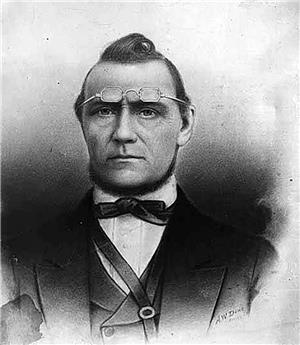On April 19, 2003, a new headstone is dedicated atop the grave of David S. “Doc” Maynard (1808-1873) at Seattle’s Lake View Cemetery. Efforts to replace the old stone, which had become weathered over time, were coordinated by members of E Clampus Vitus, Doc Maynard Outpost No. 54-50. The “Clampers” are a fraternal order that dates back to the 1849 California Gold Rush.
Matters of Grave Importance
Nearly a hundred people attended the rededication ceremonies, which began at 12 noon on an overcast spring day. Esteemed Brother Dan Kerege welcomed everyone on behalf of Doc Maynard Outpost No. 54-40, and introduced the speakers. First up was Beth Amsbury, who portrayed Catherine Maynard, Doc’s widow. Seattle City Councilman Peter Steinbrueck followed, and talked of the importance of preservation. Steinbrueck’s father Victor was instrumental in protecting Seattle’s Pike Place Market and Pioneer Square.
Leonard Garfield, directory of the Museum of History and Industry thanked the Maynard descendants for donating the original stone to the museum, where it will be put on display. Next, Cecile Hansen, chairwoman of the Duwamish tribe told of Doc Maynard’s friendship with her great-great-great uncle, Chief Noah Seattle. Sunny Speidel of the Seattle Underground Tour then told of Maynard’s important role in early Seattle history.
The next speaker was Walt Crowley (1947-2007), executive director of HistoryLink.org (this website), who talked about the dual nature of Seattle’s early history, comparing and contrasting Maynard’s colorful “can-do” attitude with the more stoic machinations of pioneer families such as the Dennys and the Borens. Brother Dan then introduced Chris Braaten and other descendants of Doc Maynard. The Clampers had consulted with members of the Maynard family to assure that the new stone met with their satisfaction.
Seattle Times columnist Jean Godden (b. 1931) spoke next, and told of her early efforts to generate interest in providing Doc Maynard with a better memorial. The ceremonies ended with a formal rededication of the gravestone by members of Masonic Lodge of St. John No 9, of which Maynard was a member.
Once all the speakers had spoken and the ceremony was complete, one of the Clampers called out the ritual question: “What say the Brethren?” In unison the clampers shouted back, “SATISFACTORY!”
The Clampers, along with Duwamish Tribe Chairwoman Cecile Hansen, then placed flowers on the nearby grave of Princess Angeline.
Credo Quia Absurdium
The Ancient and Honorable Order of E Clampus Vitus, an all-men fraternal order, got its start in the Sierra Foothills of California, following the discovery of gold at Sutter’s Mill in 1849. The first Clamper lodge -- Mokelumne Hill Lodge No. 1001-- was organized by Joe Zumwalt and other miners in September 1851.
E Clampus Vitus originally began as a parody of mystical lodges, such as the Masons, Elks, and the Odd Fellows, which Clampers thought to be much too serious with their arcane rituals and fancy dress. Over the years, E Clampus Vitus has grown to become a benevolent organization in its own right, but one that leans towards the whimsical instead of the mystical.
Whereas other fraternal organizations favored ornate sashes, aprons, and bejeweled vests, E Clampus Vitus members had a more utilitarian fashion sense. Tin can lids were cut into odd shapes and pinned to black vests worn over standard issue red union suits. The tradition carries on today, with badges, buttons, medals, and pins taking the place of “wearing the tin.”
Each Clamper has an official title of some sort, from the Noble Grand Humbug to the Clamps Matrix to the Grand Imperturbable Hangman. Some Clampers hail each other with a ritual greeting -- raising both hands to the head, with thumbs against ears and fingers extended. The Clamper motto is Credo Quia Absurdum, which roughly translates as Take Nothing Seriously, Unless It Is Absurd.
Nevertheless, the oath of every Clamper is to care for the “widows and children -- especially the widows.” When a miner fell ill or died, the Clampers would collect food and money for the unfortunate family. The Clampers may be jokesters, but behind their laughter lie hearts of gold.
Satisfactory!
When the Gold Rush days of California began to dwindle into the past, so did the Ancient and Honorable Order of E Clampus Vitus. Clampers had all but disappeared by the early 1900s, until San Francisco historian Carl Wheat “revivified” the group in 1931 as a California Historical Society. Since then, Chapters and Outposts have sprung up all along the West Coast.
Because of this, an interest in Western history is now an important part of being a Clamper. When they meet at various Halls of Comparative Ovations (usually the back rooms of saloons) the debate continues as to whether E Clampus Vitus is a Drinking Historical Society or an Historical Drinking Society. The point is moot, as all members consider themselves of “equal indignity.”
Oddly enough, while groups such as the Odd Fellows have seen their numbers diminish, Clampers have seen a resurgence in their membership rolls. Western Washington welcomed its most recent group in May 2001, with the formation of Doc Maynard Outpost No. 54-40.
Besides providing a finer headstone for their namesake member, members of Outpost 54-40 have participated in local community events, assisted the Issaquah Historical Society with the restoration of the city’s historic trolley line, and have since become members of the Association of King County Historical Organizations.
Not only that, they’ve cared for widows and orphans too.

